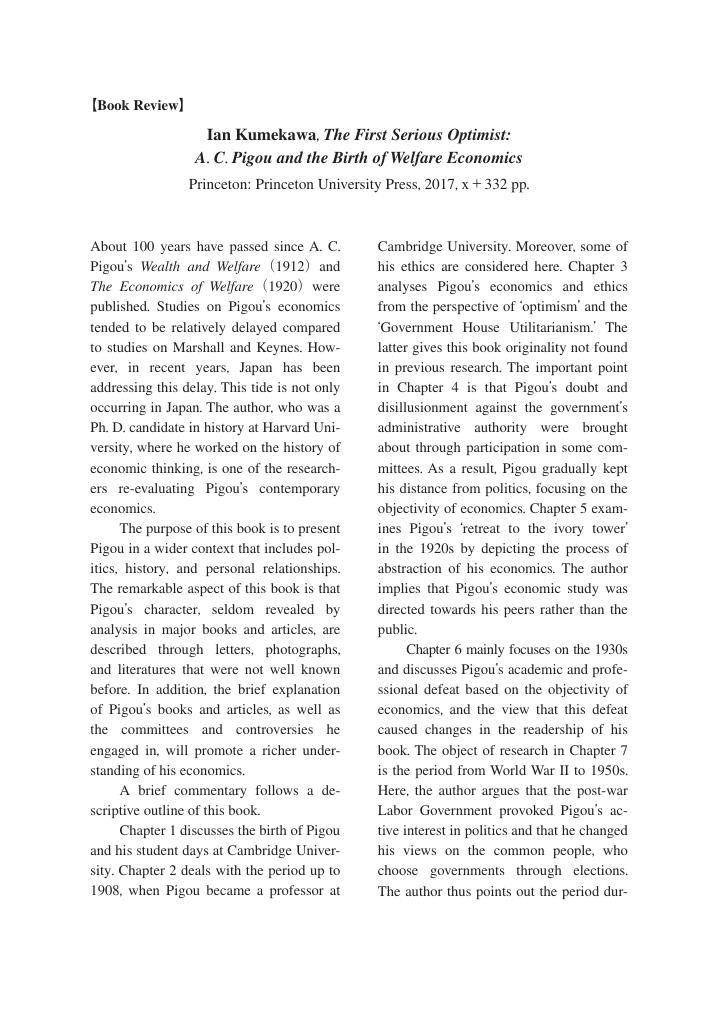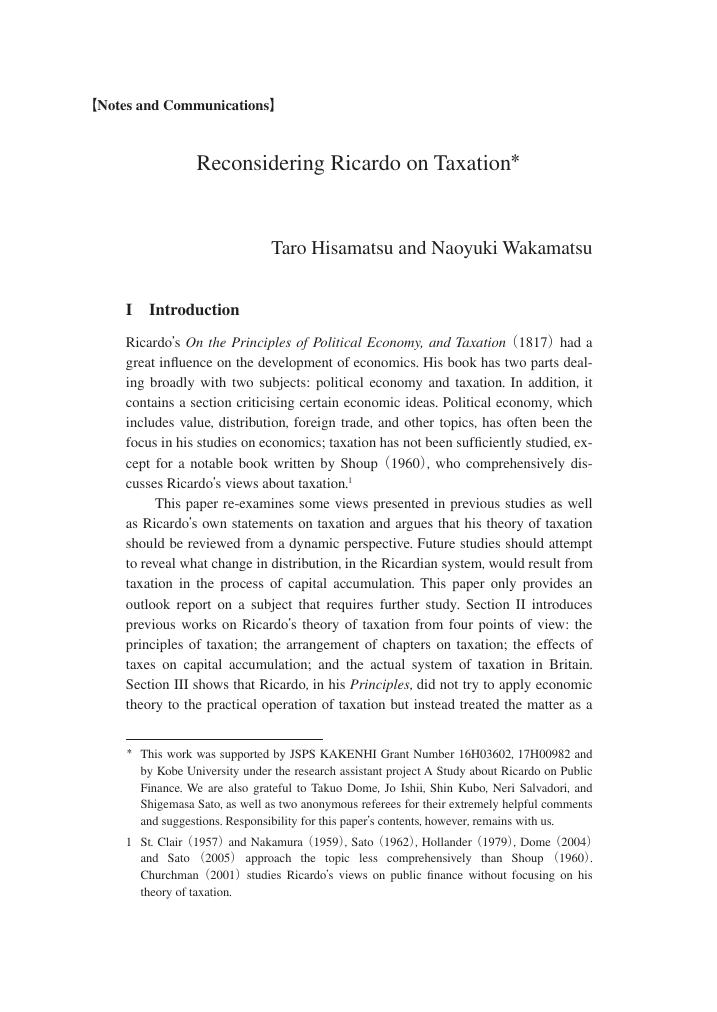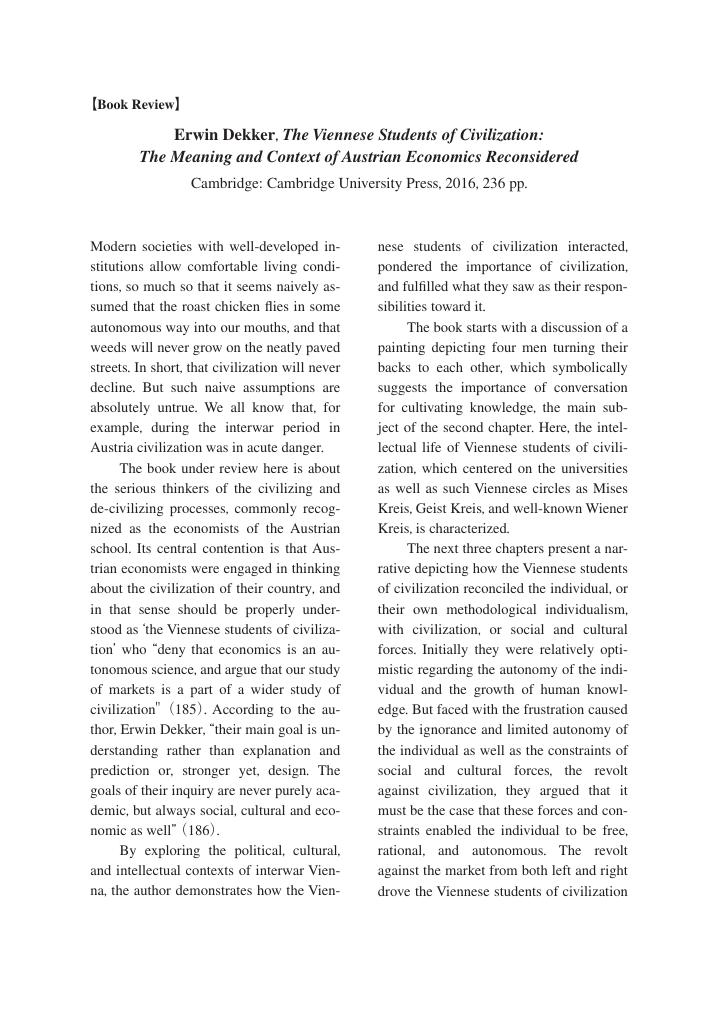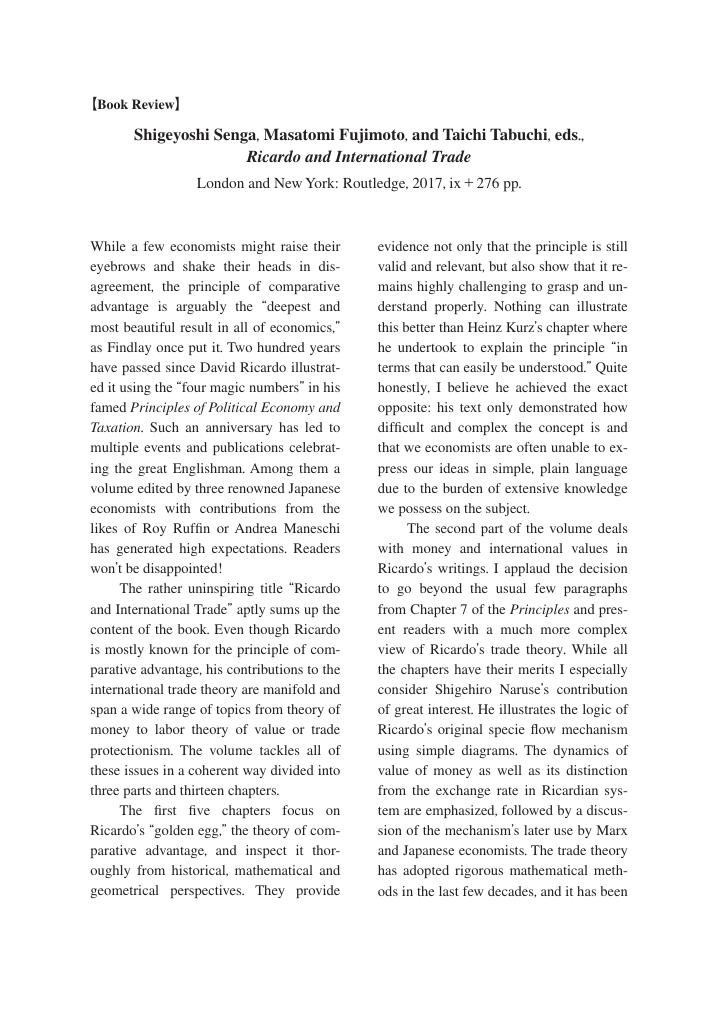- 著者
- 松本 哲人
- 出版者
- The Japanease Society for the History of Economic Thought
- 雑誌
- 経済学史研究 (ISSN:18803164)
- 巻号頁・発行日
- vol.61, no.1, pp.133-134, 2019 (Released:2019-10-14)
- 著者
- 山本 崇史
- 出版者
- The Japanease Society for the History of Economic Thought
- 雑誌
- 経済学史研究 (ISSN:18803164)
- 巻号頁・発行日
- vol.60, no.2, pp.115-116, 2019 (Released:2019-10-14)
- 著者
- 山下 範久
- 出版者
- 経済学史学会
- 雑誌
- 経済学史研究 (ISSN:18803164)
- 巻号頁・発行日
- vol.60, no.2, pp.117-118, 2019 (Released:2019-10-14)
- 著者
- 伊藤 誠一郎
- 出版者
- 経済学史学会
- 雑誌
- 経済学史研究 (ISSN:18803164)
- 巻号頁・発行日
- vol.60, no.2, pp.119-120, 2019 (Released:2019-10-14)
- 著者
- 奥田 敬
- 出版者
- 経済学史学会
- 雑誌
- 経済学史研究 (ISSN:18803164)
- 巻号頁・発行日
- vol.60, no.2, pp.121-122, 2019 (Released:2019-10-14)
- 著者
- 石井 信之
- 出版者
- 経済学史学会
- 雑誌
- 経済学史研究 (ISSN:18803164)
- 巻号頁・発行日
- vol.60, no.2, pp.123-124, 2019 (Released:2019-10-14)
- 著者
- 足立 眞理子
- 出版者
- 経済学史学会
- 雑誌
- 経済学史研究 (ISSN:18803164)
- 巻号頁・発行日
- vol.60, no.2, pp.125-126, 2019 (Released:2019-10-14)
- 著者
- 山口 拓美
- 出版者
- 経済学史学会
- 雑誌
- 経済学史研究 (ISSN:18803164)
- 巻号頁・発行日
- vol.60, no.2, pp.129-130, 2019 (Released:2019-10-14)
- 著者
- 服部 茂幸
- 出版者
- 経済学史学会
- 雑誌
- 経済学史研究 (ISSN:18803164)
- 巻号頁・発行日
- vol.60, no.2, pp.131-132, 2019 (Released:2019-10-14)
- 著者
- 若森 章孝
- 出版者
- 経済学史学会
- 雑誌
- 経済学史研究 (ISSN:18803164)
- 巻号頁・発行日
- vol.60, no.1, pp.207-208, 2018 (Released:2019-11-05)
1 0 0 0 OA 初期コモンズの通貨制度改革構想
- 著者
- 寺川 隆一郎
- 出版者
- 経済学史学会
- 雑誌
- 経済学史研究 (ISSN:18803164)
- 巻号頁・発行日
- vol.60, no.2, pp.20-41, 2019 (Released:2019-09-04)
- 被引用文献数
- 1 1
Abstract: While John R. Commons (1862―1945) is well known for his studies on American labor and Anglo-American economic law, even researchers of the history of economic thought are unfamiliar with his career-long devotion to the study of monetary questions. It was not until the 1990s that a few researchers discovered that Commons, in his later years, developed the concept of endogenous money, according to which money is a dynamic process that gets created, transferred, and extinguished alongside ongoing economic transactions. However, it is still unclear how he developed the concept in his long career as an economist. To tackle this question, this study focuses on Commons in his earliest days and reexamines his works on monetary reform published in the aftermath of the financial panic of 1893. The salient features of Commons’ money reform plan can be summarized as follows: (1) adopting “bullion notes” as base monies that are redeemable in silver at its market price, and (2) establishing a monetary commission that compiles the price index and accordingly keeps the average price at a constant level through the silver bullion open market operations. To understand the true scope of the plan, this study revisits its historical context, that is, the establishment of the international gold standard after 1873, the 1893 banking and dollar crisis, and the debate on the national banking currency after the crisis. It eventually demonstrates Commons’ early theory of money and credit, which underlies his reform plan. The study finds that Commons takes a nominalist position on the nature of money, adopts an endogenous approach on credit money supply, and recognizes a governmental role in credit administration in his money reform plan. JEL classification numbers: B15, B31, E42.
1 0 0 0 OA 菱山泉訳 スラッファ『経済学における古典と近代』
- 著者
- 菱山 泉 宮本 順介 Robert Chapeskie
- 出版者
- The Japanease Society for the History of Economic Thought
- 雑誌
- 経済学史研究 (ISSN:18803164)
- 巻号頁・発行日
- vol.60, no.2, pp.42-96, 2019 (Released:2019-09-04)
Introduction by Junsuke Miyamoto In 1956 Izumi Hishiyama and Yoshihiro Taguchi translated two essays by Piero Sraffa, ʻSulle relazioni fra costo e quantità prodottaʼ (1925) and ʻThe Laws of Returns under Competitive Conditionsʼ (1926), and published them, with the addition of commentary by Hishiyama, as Keizaigaku ni okeru Koten to Kindai-Shinkotengakuha no Kentō to Dokusenriron no Tenkai (The Classical and the Modern in Economics: The Examination of the Neoclassical School and the Development of Monopoly Theory, Tokyo: Yuhikaku) in the same year. It is the commentary by Hishiyama included in this book, ʻSraffaʼs Position in the History of Economic Thought and the Significance of his Study of Ricardo,ʼ that has been translated into English here. Izumi Hishiyama (1923-2007) began his work as a scholar with the study of François Quesnayʼs tableau économique, and the results of these efforts were brought together in ʻThe Tableau Économique of Quesnay: Its Analysis, Recon-struction and Applicationʼ (Kyoto University Economic Review, April 1960). This work received international acclaim as the first thoroughgoing attempt at a dynamic treatment of the tableau économique model. Later, Hishiyama en-countered Sraffaʼs essay ʻSulle relazioni fra costo e quantità prodotta,ʼ which made a profound impression on him, and through the intermediary of Sraffa developed an interest in classical school economics centred on David Ricardo, on the one hand, and the economics of Alfred Marshall and the Cambridge school, on the other. On the basis of an approach that involved reviving the ideas of the classical school in modern economics, Hishiyama presented a large amount of excellent research ranging from the economics of the classical school to the economics of his day. He is renowned in particular as a pioneer of Sraffian economics in Japan, and in 1962 published, together with Hiroshi Yamashita as his co-translator, a groundbreaking Japanese translation of Production of Commodities by Means of Commodities: Prelude to a Critique of Economic Theory (1960), one of Sraffaʼs most important works. In 1993 he published Sraffa Keizaigaku no Gendaiteki Hyōka (A Modern Evaluation of Sraffian Economics, Kyoto: Kyoto University Press), a text that can be described as one of his most significant works, in which he considered Sraffaʼs economics from a multi-layered perspective and attempted to establish his contribution to modern economics.
1 0 0 0 OA Reconsidering Ricardo on Taxation
- 著者
- 久松 太郎 若松 直幸
- 出版者
- The Japanease Society for the History of Economic Thought
- 雑誌
- 経済学史研究 (ISSN:18803164)
- 巻号頁・発行日
- vol.60, no.2, pp.97-101, 2019 (Released:2019-09-04)
1 0 0 0 OA ケインズと精神医学
- 著者
- 山崎 好裕
- 出版者
- 経済学史学会
- 雑誌
- 経済学史研究 (ISSN:18803164)
- 巻号頁・発行日
- vol.60, no.2, pp.106-110, 2019 (Released:2019-09-04)
- 著者
- 荒川 憲一
- 出版者
- 経済学史学会
- 雑誌
- 経済学史研究 (ISSN:18803164)
- 巻号頁・発行日
- vol.60, no.2, pp.111-112, 2019 (Released:2019-10-14)
- 著者
- 中井 大介
- 出版者
- The Japanease Society for the History of Economic Thought
- 雑誌
- 経済学史研究 (ISSN:18803164)
- 巻号頁・発行日
- vol.60, no.2, pp.113-114, 2019 (Released:2019-10-14)
- 著者
- 北田 了介
- 出版者
- 経済学史学会
- 雑誌
- 経済学史研究 (ISSN:18803164)
- 巻号頁・発行日
- vol.60, no.1, pp.189-190, 2018 (Released:2019-11-05)
- 著者
- 尾近 裕幸
- 出版者
- The Japanease Society for the History of Economic Thought
- 雑誌
- 経済学史研究 (ISSN:18803164)
- 巻号頁・発行日
- vol.60, no.1, pp.191-192, 2018 (Released:2019-11-05)
- 著者
- 藤田 菜々子
- 出版者
- 経済学史学会
- 雑誌
- 経済学史研究 (ISSN:18803164)
- 巻号頁・発行日
- vol.60, no.1, pp.193-194, 2018 (Released:2019-11-05)
- 著者
- Martin Grančay
- 出版者
- The Japanease Society for the History of Economic Thought
- 雑誌
- 経済学史研究 (ISSN:18803164)
- 巻号頁・発行日
- vol.60, no.1, pp.195-196, 2018 (Released:2019-11-05)

















